by Susan Flantzer © Unofficial Royalty 2019
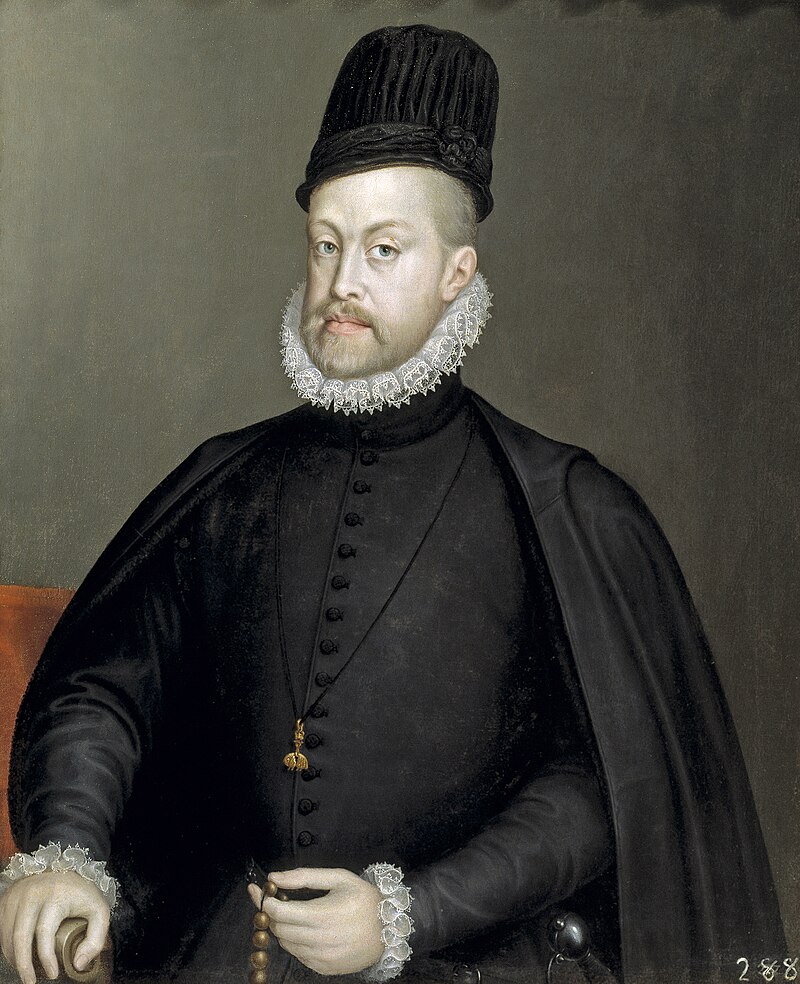
Felipe II, King of Spain, Filipe I, King of Portugal; Credit – Wikipedia
Besides being King of Spain (1555 – 1598), Philp (Felipe in Spanish) was also King of Portugal (1581 – 1598), King of Naples and Sicily (1554 – 1598), Duke of Milan (1540 – 1598), Lord of the Seventeen Provinces of the Netherlands (1555 – 1598) and jure uxoris (by right of his wife) King of England and Ireland during his marriage to Queen Mary I of England from 1554 until Mary died in 1558.
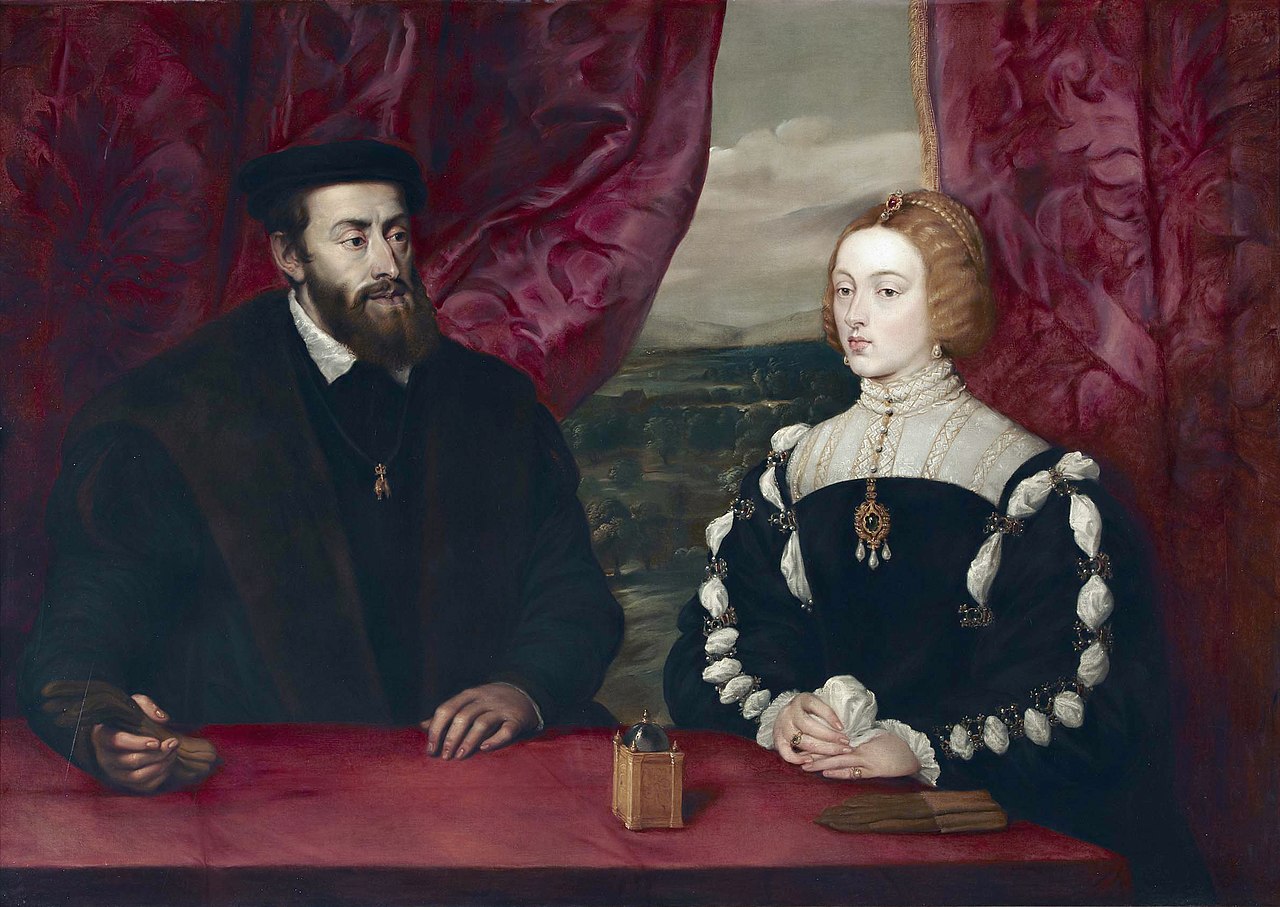
Philip’s parents, Holy Roman Emperor Charles V and Isabella of Portugal; Credit – Wikipedia
Philip was born on May 21, 1527, at Palacio de Pimente in Valladolid, then the capital of Spain. He was the oldest child of King Carlos I of Spain, who was also Charles V, Holy Roman Emperor, and Isabella of Portugal, daughter of King Manuel I of Portugal and his second wife Maria of Aragon. Philip’s father Charles was the heir to three of Europe’s leading dynasties: Valois of Burgundy, Habsburg of Austria, and Trastámara of Spain. He was the first to rule a unified Spain. As a Habsburg, he inherited Austria and other lands in central Europe and was also elected to succeed his grandfather, Maximilian I, as Holy Roman Emperor.

The Baptism of Phillip II, ceiling preserved in Palacio de Pimentel in Valladolid; Credit – Wikipedia
Philip was a descendant of King Ferdinand I of Aragon and Queen Isabella I of Castile (Trastámara dynasty of Spain):
King Ferdinand I of Aragon married Queen Isabella I of Castile → Queen Juana I of Castile married Philip of Habsburg, Duke of Burgundy → Charles V, Holy Roman Emperor married Isabella of Portugal → Philip II of Spain
He was also a descendant of Charles the Bold, Duke of Burgundy (Valois dynasty of Burgundy):
Charles the Bold, Duke of Burgundy married Isabella of Bourbon → Mary, Duchess of Burgundy married Maximilian I, Holy Roman Emperor → Philip, Duke of Burgundy married Juana I, Queen of Castile and León, Queen of Aragon → Charles V, Holy Roman Emperor married Isabella of Portugal → Philip II of Spain
And he was a descendant of Friedrich III, the first Holy Roman Emperor of the House of Habsburg (Habsburg dynasty of Austria): Friedrich III, Holy Roman Emperor married Eleanor of Portugal → Maximilian I, Holy Roman Emperor married Mary, Duchess of Burgundy → Philip, Duke of Burgundy married Juana I, Queen of Castile and León, Queen of Aragon → Charles V, Holy Roman Emperor married Isabella of Portugal → Philip II of Spain
Philip had four siblings:
- Maria (1528 – 1603), married her first cousin Maximilian II, Holy Roman Emperor, had sixteen children
- Ferdinand (1529 – 1530), died in infancy
- Joanna (1535 – 1573), married her first cousin Prince João Manuel of Portugal, had one son
- Juan (1537 – 1538), died in infancy
Philip was well-educated and received an academic education that reflected the spirit of the Renaissance. He studied the works of the humanist movement, mathematics, science, and religion. In addition to his native Spanish, Philip was fluent in Portuguese and Latin but had difficulty learning German and French. He also received instruction in hunting, jousting, dance, and music. Throughout his life, Philip had a passion for collecting works of art, relics, mechanical instruments, and especially books. His private library was considered the largest in the Western world. His collection had more than 13,500 volumes including manuscripts in Greek, Hebrew, and Arabic. As an adult, Philip developed great interests in geography, cartography, architecture, and nature.
Philip married four times, was a widower four times, and had children with three of his wives.
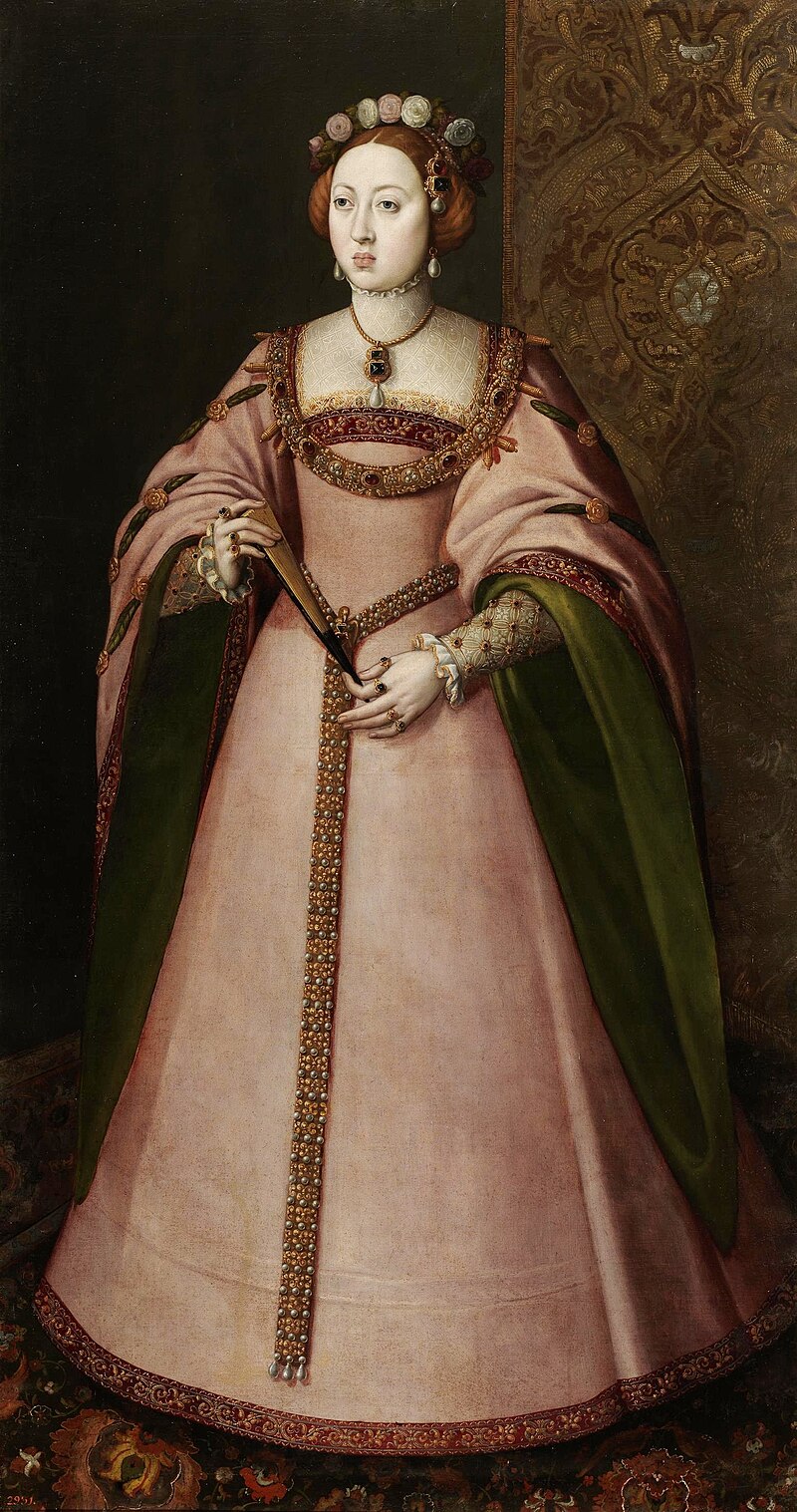
Maria Manuela; Credit – Wikipedia
(1) Maria Manuela, Princess of Portugal (1527 – 1545), Philip’s double first cousin, daughter of Philip’s maternal uncle King João III of Portugal and his paternal aunt Catherine of Austria. They were married in Salamanca, Spain on November 12, 1543. Philip and Maria Manuela had one son and Maria died four days later due to childbirth complications. She was initially buried in the Royal Chapel of Granada but in 1549 but her remains were transferred to the Royal Crypt of the Monastery of El Escorial.
- Carlos, Prince of Asturias (1545 – 1568), died unmarried, Carlos was mentally unstable and was imprisoned in his rooms by Philip in early 1568 after participating in a plot to murder Philip.

Philip and Mary, Bedford Collection, Woburn Abbey; Credit – Wikipedia
(2) Queen Mary I of England (1516 – 1558), Philip’s first cousin once removed, daughter of King Henry VIII of England and Catherine of Aragon
In 1554, Philip made a political marriage with his first cousin once removed, Queen Mary I of England. Roman Catholic Mary was 37, and it was vital that she marry and produce a Catholic heir to supplant her Protestant sister Elizabeth. Edward Courtney, 1st Earl of Devon, a Plantagenet descendant, was suggested. However, Mary had her heart set on marrying Philip, the only son of Mary’s first cousin Charles V, Holy Roman Emperor. Philip was a widower and was eleven years younger than Mary. Parliament begged her to reconsider fearing the threat of a marriage to a foreign royal might have for English independence. When Mary insisted on marrying Philip, a rebellion broke out, led by Thomas Wyatt, to depose Mary in favor of her half-sister Elizabeth. Wyatt marched on London but was defeated and executed.
Mary and Philip were married at Winchester Cathedral on July 25, 1554. Mary insisted that Philip receive the title of King and that all official documents be in both their names. The marriage was not successful. Although Mary was in love with Philip, he found her repugnant. In September 1554, Mary thought she was pregnant and continued to exhibit signs of pregnancy until July 1555, when her abdomen returned to normal. There was no baby. After fourteen months of marriage, Philip returned to Spain in August 1555. Mary was heartbroken and went into a deep depression. Philip did return to England in 1557 and was happily received by Mary. Philip wanted England to join Spain in a war against France. Mary agreed and the result was the loss of Calais, England’s last remaining possession in continental Europe. Philip left England in July 1557, never to return. Mary said of these losses, “When I am dead, you will find the words ‘Philip’ and ‘Calais’ engraved upon my heart.” Mary died in 1558 and was buried in Westminster Abbey in London, England.
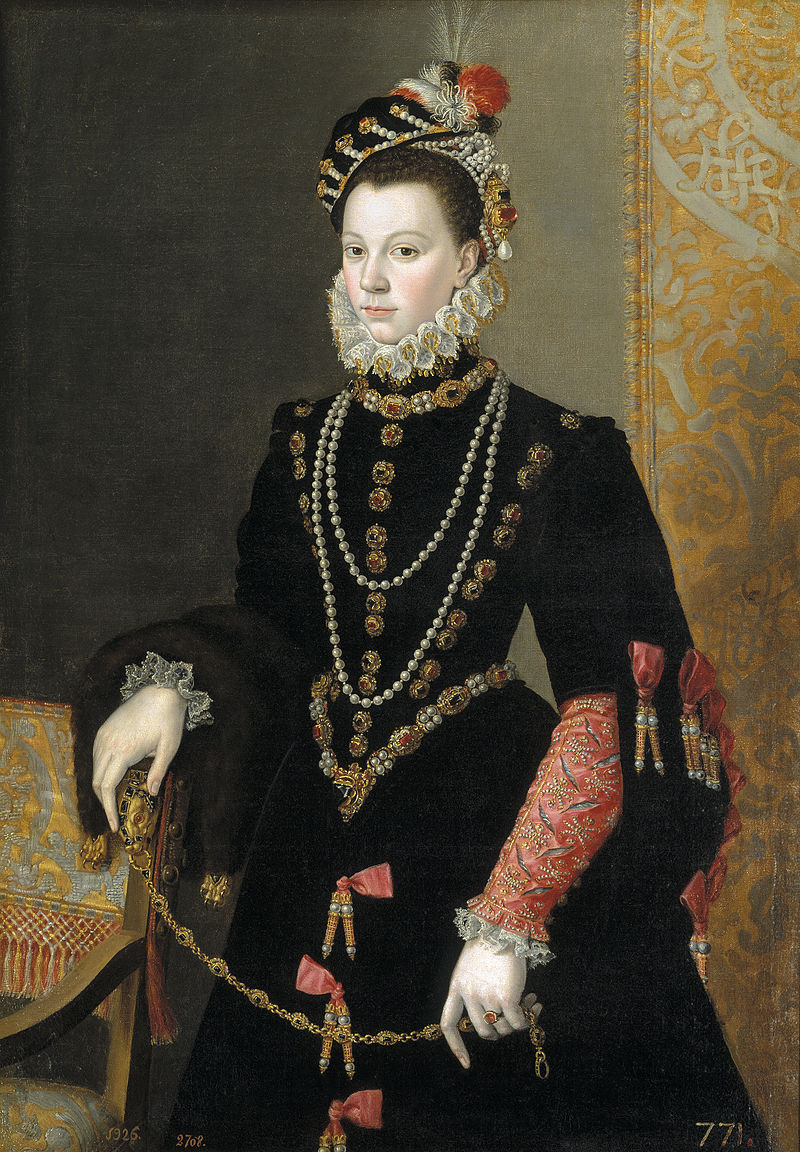
Elisabeth of Valois; Credit – Wikipedia
(3) Elisabeth of Valois (1545 – 1568), daughter of King Henri II of France and Catherine de’ Medici. They were married by proxy in 1559 at Notre-Dame Cathedral in Paris, France and then in person in Guadalajara, Spain. Philip and Elisabeth conceived five daughters and a son but only two of the daughters survived. Elisabeth died on October 3, 1568, a few hours after giving birth to a premature daughter who also died and was buried at the Royal Crypt of the Monastery of El Escorial.
- Stillborn son (1560)
- Miscarried twin daughters (1564)
- Infanta Isabella Clara Eugenia (1566 – 1633), married Albert VII, Archduke of Austria, no children
- Infanta Catherine Michelle (1567 – 1597), married Carlo Emmanuel I, Duke of Savoy, had ten children
- Juana, premature daughter (born and died October 3, 1568)

Anna of Austria; Credit – Wikipedia
(4) Anna of Austria (1549 – 1580), Philip’s niece, daughter of Maximilian II, Holy Roman Emperor, and Maria of Spain, who was Philip’s sister. They were married by proxy on May 4, 1570, at Prague Cathedral and in person at the Chapel of the Alcázar de Segovia in Spain on November 14, 1570. This was a happy marriage and Philip and Anna had five children. Anna died from influenza at the age of 30, on October 26, 1580, eight months after giving birth to her youngest child, and was buried at the Royal Crypt of the Monastery of El Escorial.
- Ferdinand, Prince of Asturias (1571 – 1578), died in childhood of dysentery
- Infante Carlos Lorenzo (1573 – 1575), died in childhood
- Diego, Prince of Asturias (1575 – 1582), died in childhood of smallpox
- King Felipe III of Spain (1578 – 1621), succeeded his father as king, married Margaret of Austria, had eight children
- Infanta Maria (1580 – 1583), died in childhood
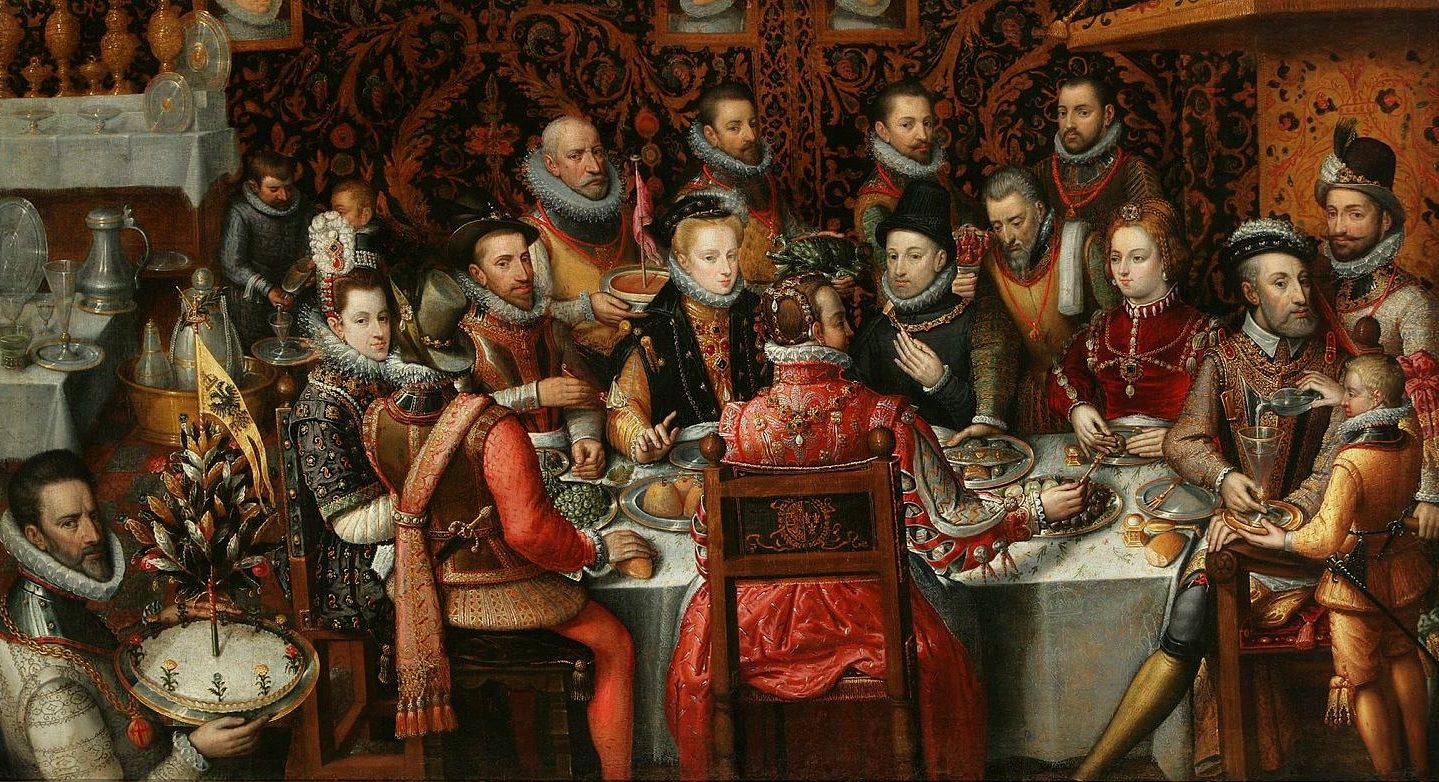
Philip and Anna banqueting with family and courtiers by Alonso Sánchez Coello; Credit – Wikipedia
Physically exhausted after 40 years of ruling, Philip’s father Charles abdicated in 1555 and retired to the peace of a monastery, where he died three years later. Upon Charles’s abdications, the Holy Roman Empire was inherited by his younger brother Ferdinand, who had already been given the Austrian lands in 1521. The Spanish Empire, including the possessions in the Netherlands and Italy, was inherited by Philip. The two empires would remain allies until the 18th century when the Spanish branch of the House of Habsburg became extinct.

The Royal Site of San Lorenzo de El Escorial; Credit – By Turismo Madrid Consorcio Turístico from Madrid, España – Monasterio EscorialUploaded by Ecemaml, CC BY 2.0, https://commons.wikimedia.org/w/index.php?curid=6581920
Philip II was a devout Catholic and was vehemently against the Protestant Reformation. He felt the need to enforce Catholicism in the countries he governed and to forcibly repudiate the ever-increasing Protestantism via the Spanish Inquisition. This led to numerous military conflicts with the Netherlands and with England, against which he sent the Spanish Armada on its unsuccessful mission in 1588. Due to the enormous gold and silver received from his American possessions, the Spanish Empire under Philip reached the height of its global supremacy including a flourishing of art and culture. Philip built The Royal Site of San Lorenzo de El Escorial (known as El Escorial) near Madrid, which served as a monastery, basilica, royal palace, burial pantheon, library, museum, university, school, and hospital. Today, it is still the traditional burial site of the Spanish royal family. Due to the many military conflicts, the power of the Spanish Empire was already declining towards the end of Philip’s reign.
In 1578, King Sebastian of Portugal from the House of Aviz was killed in battle without any heirs, causing a succession crisis. He was succeeded by his elderly great-uncle Henrique, a Cardinal of the Roman Catholic Church who had no descendants because he had taken a vow of chastity as a priest. When Cardinal-King Enrique died two years later, three grandchildren of Manuel I, King of Portugal (1469 – 1521) claimed the Portuguese throne. Ultimately, the grandchild who was successful in his claim was Felipe II, King of Spain. The Iberian Union was the union of the Kingdom of Spain and the Kingdom of Portugal that existed between 1580 and 1640, under the Spanish Habsburg kings Felipe II, Felipe III, and Felipe IV who reigned in Portugal under the names Filipe I, Filipe II, and Filipe III.

King Philip II of Spain; Credit – Wikipedia
Toward the end of his life, Philip’s health suffered. In 1595, gout was causing him severe pain, making him nearly immobile, and a special wheelchair was made for him. He also suffered from recurring episodes of malaria. Philip’s daughter Isabella Clara Eugenia was a great comfort to him. She helped her father with government business, arranged his documents, read important messages, and translated Italian reports into Spanish. During the last three months of his life, Philip was bedridden and in great agony. He died at the age of 71 on September 13, 1598, in his chambers at the El Escorial. Philip was buried in the Pantheon of the Kings, the mausoleum of the Spanish kings in the crypt of the palace church of the El Escorial.
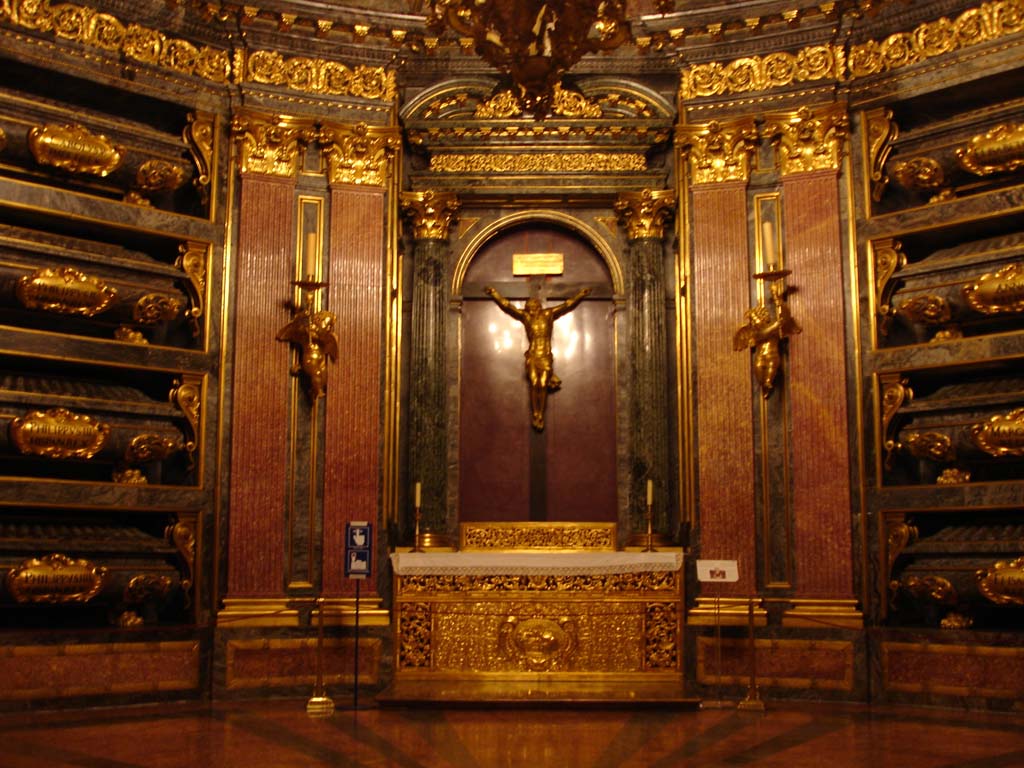
The Pantheon of the Kings at El Escorial; Credit – Wikipedia
This article is the intellectual property of Unofficial Royalty and is NOT TO BE COPIED, EDITED, OR POSTED IN ANY FORM ON ANOTHER WEBSITE under any circumstances. It is permissible to use a link that directs to Unofficial Royalty.
Works Cited
- De.wikipedia.org. (2018). Philipp II. (Spanien). [online] Available at: https://de.wikipedia.org/wiki/Philipp_II._(Spanien) [Accessed 8 Sep. 2018].
- En.wikipedia.org. (2018). Charles V, Holy Roman Emperor. [online] Available at: https://en.wikipedia.org/wiki/Charles_V,_Holy_Roman_Emperor [Accessed 8 Sep. 2018].
- En.wikipedia.org. (2018). Philip II of Spain. [online] Available at: https://en.wikipedia.org/wiki/Philip_II_of_Spain [Accessed 8 Sep. 2018].
- Es.wikipedia.org. (2018). Felipe II de España. [online] Available at: https://es.wikipedia.org/wiki/Felipe_II_de_Espa%C3%B1a [Accessed 8 Sep. 2018].
- Flantzer, S. (2016). Queen Mary I of England. [online] Unofficial Royalty. Available at: https://www.unofficialroyalty.com/queen-mary-i-of-england/ [Accessed 8 Sep. 2018]
- Wheatcroft, A. (1995). The Habsburgs. London: Viking.
